The British Uncanny
Reusing Surrealist Energies in Jessica Harrison’s Art
Maurizia Paolucci
English abstract
I shed the dulling armor plates
That once collected radiance
And surging at the blood’s perimeter
The half-remembered wild interior
Of an animal life
― Shearwater, Animal Life
[© Jonathan Meiburg 2012
Quoted by kind permission of Sub Pop Records]
Paris 1938: the Exposition Internationale du Surréalisme displays rented female mannequins that have been modified in disturbing ways, ranging from the cage enclosing the head of André Masson’s to the moss and fungi covering the body of Wolfgang Paalen’s and the beetles on the face of Sonia Mossé’s. The corridor the mannequins are displayed all along leads into a poorly lit womblike room that is at once cosy and gloomy; actress Hélène Vanel has given a performance on the opening night, feigning a hysterical attack. Edinburgh’s countryside 2014: in an all-pink space, Jessica Harrison’s Broken solo exhibition displays found ceramic lady figurines that, though heavily mutilated by the 1982-born British sculptor, do not come across as hard done-by passive recipients of violence at all. This is one of two remarks about Harrison’s figurines that are consistently made.
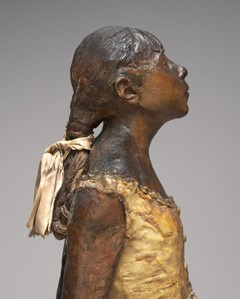
1 | Detail from Edgar Degas, Little Dancer Aged Fourteen, mixed media, 1878-1881, National Gallery of Art, Washington.

2 | Fernando Vicente, American Housewife from the series Venus, acrylic on canvas, 2011, in possession of the artist at the time of submission of this paper.

3 | Fernando Vicente, Carne d’Amour from the series Vanitas, acrylic on canvas, 2007, private collection.

4 | Jessica Harrison, Lily from the series Broken, found ceramic figurine, epoxy resin, and enamel paint, 2013, private collection. Style identified by Giuliana Gardelli as ca. 1760.
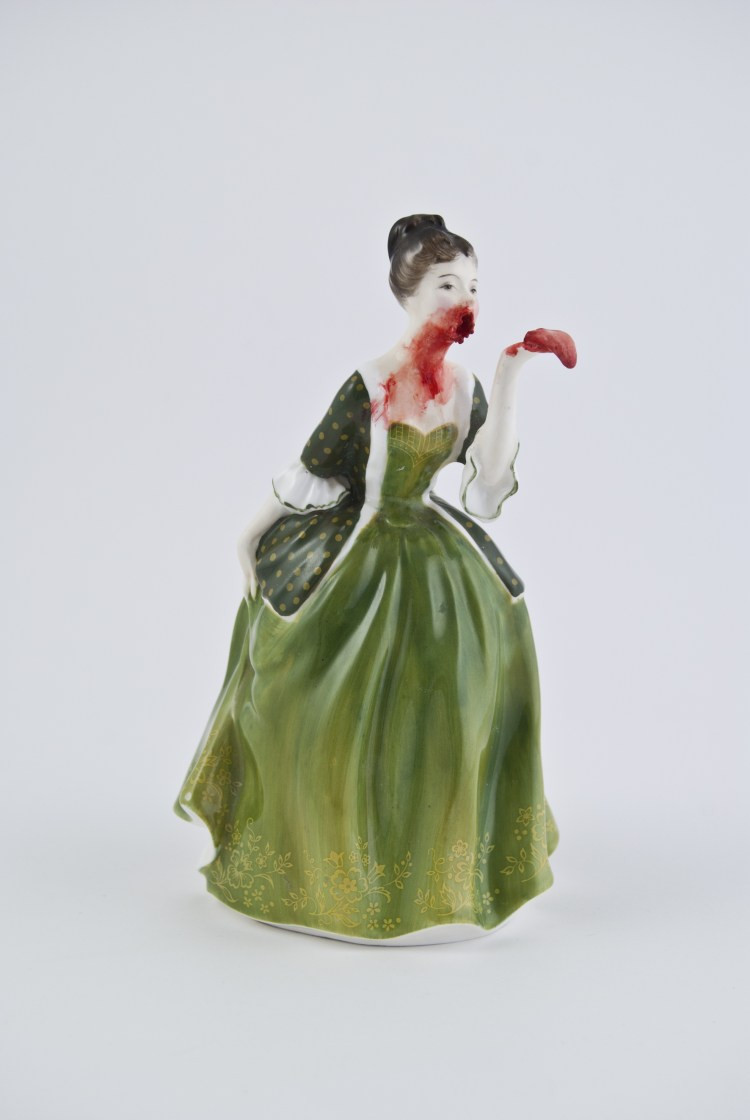
5 | Jessica Harrison, Jane from the series Broken, found ceramic figurine, epoxy resin, and enamel paint, 2011, private collection. Style identified by Giuliana Gardelli as eighteenth/nineteenth-century.
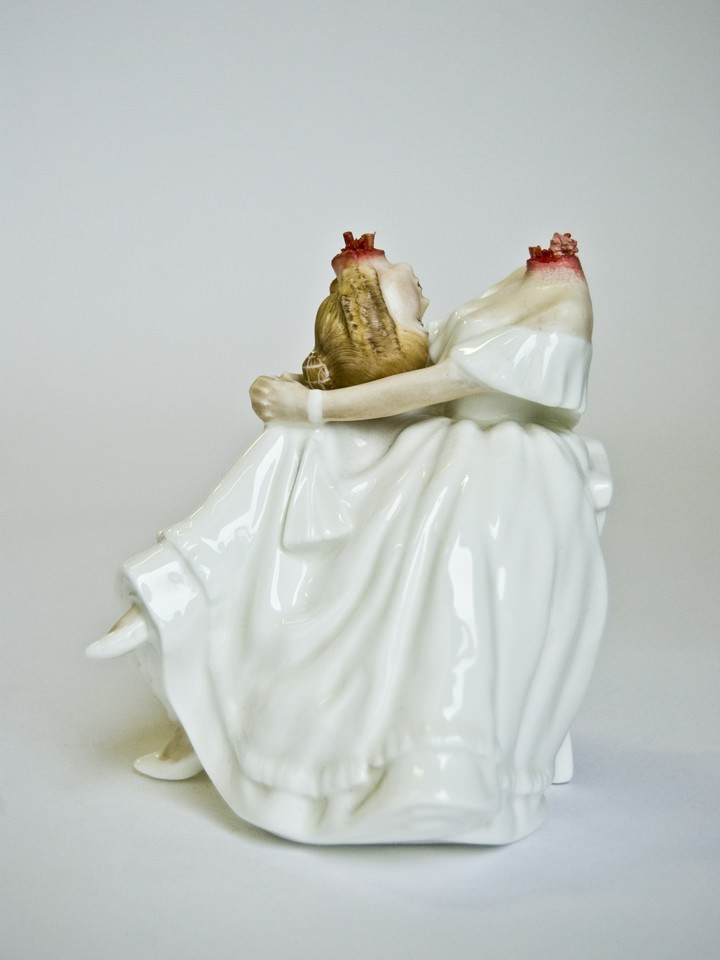
6 | Jessica Harrison, Georgina from the series Broken, found ceramic figurine, epoxy resin, and enamel paint, 2011, private collection. Style identified by Giuliana Gardelli as ca. 1801-10.
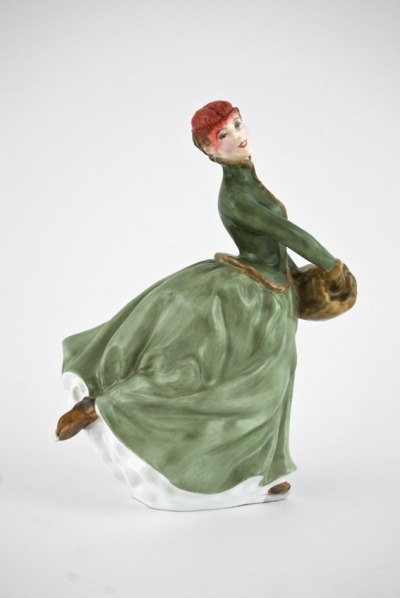
7 | Jessica Harrison, Amy Jane from the series Broken, found ceramic figurine, epoxy resin, and enamel paint, 2010, private collection. Style identified by Giuliana Gardelli as Victorian.
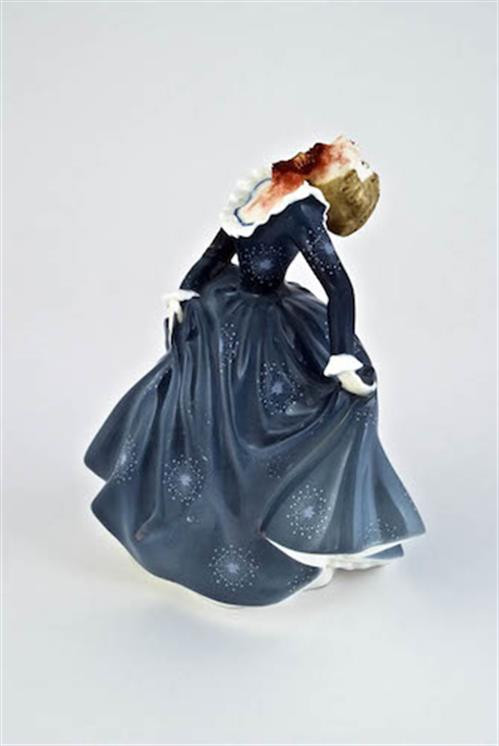
8 | Jessica Harrison, Elisabeth from the series Broken, found ceramic figurine, epoxy resin, and enamel paint, 2011, private collection. Style identified by Giuliana Gardelli as Victorian.

9 | Jessica Harrison, Ethel from the series Broken, found ceramic figurine, epoxy resin, and enamel paint, 2013, private collection. Style identified by Giuliana Gardelli as Victorian.

10 | Aubrey Beardsley, Cutting the Lock of Hair for The Rape of the Lock, pen and ink drawing, 1896, original in private collection.

11 | Aubrey Beardsley, The Coiffing for The Ballad of a Barber, pen and ink drawing, 1896, original at the Cleveland Museum of Fine Art, Cleveland.
“You have to hand it to the ladies, they still managed to keep their poise and smile for the camera” (del Castillo 2013); “The women appear as hostesses to their own injuries, eerily ever pleasant” (Olda 2013); “Dancing gaily with a half exposed brain [...] these ladies are being depicted as the active agents of their own desires” (West 2014 [emphasis mine]); “The juxtaposition of the prim statuettes displaying their decapitated heads and freshly opened throats without changing their demure expressions is striking. Despite having appeared to have been subjected to an awful violence (perhaps their own), the Georgian and Victorian-era figures remain decorous figures” (hubs 2016 [emphasis mine]): statements such as these are all the more useful for understanding the unique nature of Harrison’s work in that, besides being hardly applicable to the Surrealists’ mannequins, they are also quite different from what has been written about the work of another prominent figure in the contemporary ‘gore art’ scene.
The dissected women by Spanish painter Fernando Vicente (born 1963) have been described as “disinterested, cold [...] calm, as if unaware of the exposition” (zanimon 2012). Vicente’s paintings are glamorous, like the photographs on fashion magazines; the ‘butchering’ in them is neat and tidy, reminiscent of “cold anatomical plates” (Gori 2014); they have been said to “question our society’s sexual exposure of women in fashion” (ivi). To me, what underlies Vicente’s work is traceable back to Edgar Degas’s portrayal of the condition of the female performer, lusted after and yet frowned upon. Originally exhibited inside a glass case, Degas’s Little Dancer Aged Fourteen tells the story of a beautiful outcast. Sculpted in red beeswax, the girl’s skin appears pockmarked; her features were called monkeylike, that was exactly what Degas aimed for. Throughout Christian art, the monkey had been a symbol of lust; taking advantage of the period-typical fascination with the illustrations of humanised animals, and drawing on the physiognomic theory revived and popularised by Johann Kaspar Lavater in the previous century, Degas gave the young ballerina monkeylike features to signify that she was a prostitute (and he would exhibit the work in 1881 alongside his portraits of some criminals). Being a prostitute, she was pockmarked from having syphilis; and, being poxy, she belonged in a glass case. The glass case was, in fact, one with the girl in Degas’s mind: unable to exhibit the sculpture at the fifth Impressionist exhibition in 1880, he simply exhibited the empty container (Mori 2004, 37-39). I believe that it is not by chance that Degas used horsehair for the girl’s hair, seeing as, among “the aging aristocratics and business tycoons” attending the Opéra, “the dancers were referred to as fillies who could be mounted, re-mounted, or exchanged for a new mount” (Foster [1995] 1996, 9); in his Petit mémoirs de l’Opéra (1857), Charles de Boigne had compared “the ballerina to a horse, remarking derogatorily that horses look good after battle” while the ballerina no longer looks good once she is sweaty and panting after performing (ivi, 21). Vicente takes all this to the extreme, effectively conjuring the still largely ongoing bashing and debasement of women ‘guilty’ of working in performing arts. It is interesting that he gave a series of paintings the title Vanitas. This “might be interpreted as a classical commentary on human nature – we are all the same underneath, death is universal. But seeing it this way might obscure the more subtle and sophisticated dimension of Vicente’s works. The word vanitas in Latin, meaning ‘emptiness’ [...] points toward a more disturbing possibility. The models appear so insulated [...] as if they have built up a sophisticated carapace” to protect themselves (zanimon 2012).
This is not the case with Harrison’s women: in the artist’s words, “They’re all participating in their own turning inside out. I take the pose that they’re exhibiting and I work with that pose, so they’re not being subjected to this disembowelment, or decapitation; they’re actually participating, they’re turning themselves inside out, they’re pulling off their own heads, they are the ones that are exposing themselves to us, really. They’re very much initiating their own demise” (West 2014 [emphasis mine]). What makes Harrison’s art so powerful is her freeing and exploiting the potential of the found object. In modifying found lady figurines like the Surrealists used to modify mannequins and dolls, she does something unprecedented: taking each figurine’s posture and gesture into account and starting working from there. In fact, Harrison specifies, she wants her modifications to emphasise the movement of the figurine (Finel Honigman 2014). Before I delve further into this, I want to introduce the other remark that is frequently made about Harrison’s figurines: they are often called “Georgian” and “Victorian”.
“The Georgian and Victorian-era figures remain decorous figures” (hubs 2016); “Georgian and Victorian-era idyllic figures” (Olda 2013); “Victorian elegance and sophistication” (del Castillo 2013); “Sculptor Jessica Harrison [...] has forever changed how we see Victorian-era ceramic figures” (del Castillo 2014). The remark has also been expanded upon: by Ellyn Ruddick-Sunstein, with regard to a series where the figurines sport tattoos (“The Victorian doll is a symbol of feminine delicacy and piety, but [...] Where Victorian women were encouraged to be sexually modest, religious and sober, Harrison’s dolls adopt the visual language associated with drunkenness and sexual freedom on the high seas [...] Harrison’s impressive series coyly lays bare the deeply entranched sexism, racism, and classism of the Victorian era” – Ruddick-Sunstein 2014), and by Michael Stewart:
Harrison forces her audience to recognise their own conditioning in general while questioning the Victorian concept of the female form specifically, touching on attendant issues such as the manipulation of body shape through costume, gender roles, repression and conformity. This has a modern parallel. Today, we are surrounded by imagery which promotes a view of what we should consider beautiful, of what constitutes physical perfection. The Victorian preoccupation with elegance, grace and virtue has been replaced by our fixation on body shape and surgical enhancement. Harrison highlights these issues by comparing and contrasting our own society with that of the Victorian’s [sic]; outwardly unblemished, seamless and superficially attractive but internally flawed; built upon an inconsistent and frequently contradictory value system.
Harrison’s work provides us with the perfect metaphor for two societies separated by a century but remarkably similar in terms of their capacity for hypocrisy; namely the Victorian era and our own; the veneer of civilisation covering up a fascination with the sordid, decadent and macabre. The Victorian’s [sic] created an environment that engendered Jack the Ripper, paraded John Merrick as “The Elephant Man” and turned a blind eye to widespread poverty and injustice. In the 21st century, we have reality television. Jessica Harrison’s sculptures are the Victorian freak show brought directly to your mantelpiece (Stewart 2014).
Blogger hubs works outside the art field; Danny Olda is an art journalist – like Ellyn Ruddick-Sunstein – and a curator; Inigo del Castillo is a graphic designer; Michael Stewart works in arts education. I thought that their statements, if adequately backed up, had the potential for casting a very interesting light on Harrison’s work, given the fascination that both the eighteenth and the nineteenth century exerted over the Surrealists. The style of the figurines is not a criterion Harrison chooses them by, so she was not able to provide me with any more information about this over email. After selecting some figurines whose poses were particularly interesting, I showed them to Giuliana Gardelli, Head of the Porcelains and Ceramics Department at Bertolami Fine Arts Auction House in Rome, who confirmed their styles to be Georgian (term covering years 1714-1837) and Victorian (years 1837-1901). (An important clarification is needed: it is only the style that is being discussed, seeing as the found figurines are not actually from the eighteenth and nineteenth centuries; most of them, for example, were made – Harrison told me – between 1970 and 2000 by British company Royal Doulton).
Among the major influences on the Surrealists was a Frenchman who lived from 1740 to 1814, a timeline encompassed within the Georgian era in Britain: the Marquis de Sade, libertine, revolutionary, and madman, whose thought the Surrealist practice of mutilating and violating female dolls and mannequins is heavily indebted to. The Surrealists – from Georges Bataille’s claim that Manet’s Olympia is decapitated by her ribbon to Valentine Penrose’s enlarging upon the necklace that sprang Countess Báthory’s Iron Maiden into action – proved equally fond of the theme of the accessory carrying dark implications; a theme that does indeed pair well with the eighteenth-century aesthetic, as appears evident in Alexander Pope’s poem The Rape of the Lock. Written in 1712, during the reign of Queen Anne (prior, therefore, to the Georgian era), and shot through with eighteenth-century lightness and frivolity, the poem features a beauty tool – a pair of hair cutting scissors – turning into violation tool when a man cuts off a lock of the heroine’s hair without her consent. In the Victorian era, Aubrey Beardsley – among the illustrators for The Rape of the Lock– will make this even darker by writing and illustrating a poem where a hairdresser uses his scissors to kill the object of his desire. Holding their heart like a mirror, their intestines like a stole, Harrison’s eighteenth- and nineteenth-century-esque ladies are an astounding variation on that, the Surrealist-flavoured operation performed on them a perfect complement to the styles they happen to be in. Their being “the active agents of their own desires” takes a peculiar wit further that is discernible in The Rape of the Lock, where the heroine, Belinda, albeit the recipient of the violent act, is, in a way, revolutionary. When she has her lock cut, a gnome flies down to the “Cave of Spleen” – an obvious metaphor for premenstrual syndrome, or better yet, for hysteria as it was understood before psychoanalysis – “to fetch the rage and tears she needs in order to claim it back [...] he pulls Belinda out of her frozen state by just fetching her own spleen” (Paolucci 2017); though everything is told in comedic tones, she is de facto able to rebel against her violator thanks to her menstruation, thus far thought of only as what potentially enables her to conceive children; something that is inside of her, untalked of, labelled disgusting – the “Abject” art scholars have extensively written about.
Also encompassed within the Georgian era is the Enlightenment. According to Terry Castle, it was the eighteenth century (most notably British) that “in a sense, “invented the uncanny” [...] the very psychic and cultural transformations that led to the subsequent glorification of the period as an age of reason or enlightenment – the aggressively rationalist imperatives of the epoch – also produced, like a kind of toxic side effect, a new human experience of strangeness” (Castle 1995, 8). Castle’s collection of essays The Female Thermometer is a wild ride through eighteenth-century British culture, analysed in the light of Sigmund Freud’s concept of the uncanny (the effect produced by encountering familiar things in an unsettling context or light where what was supposed to remain hidden comes to the forefront and out in the open): masquerades temporarily blurring “cherished distinctions” (ivi, 17) and being simultaneously inscribed “in a code of danger and in a code of pleasure” (ivi, 105), Samuel Richardson’s libertine villain Lovelace praising “the usefulness of dreams in providing “plots” for enterprising fellows, and cunning rakes in particular” (ivi, 59), the obsession with phantasmagoria ghost shows, and, what is most relevant to my purpose to analyse Harrison’s work, the one with automata: Harrison’s eighteenth-century-esque ladies can be easily imagined as eighteenth-century automata performing something new – opening up themselves.
Nineteenth-century energies, as Sheldon Nodelman demonstrates in discussing Marcel Duchamp’s 1937 reenactement of a fin-de-siècle favourite like Salome and St. John the Baptist’s story, were breathtakingly reused in Surrealist ways, despite “the harsher winds of the 20th century” having “swept away the perfumed vapors of Decadent sensibility” (Nodelman 2006, 110). An article submitted in 1936 by Salvador Dalí to the Surrealist journal “Minotaure” showed how the painter looked up to some Victorian artists specifically: “The Pre-Raphaelites place on the table the sensational dish of the eternal feminine livened up with a touch of highly respectable ‘repugnance’” (Dalí [1936] 1998, 311-12); “These carnal concretions of excessively ideal women, these feverish and panting materialisations, these floral and soft Ophelias and Beatrices produce in us, as they appear to us through the luminescence of their hair, the same effect of terror and unequivocal alluring repugnance of that of the soft belly of a butterfly seen between the luminescences if its wings” (ivi, 312). It was a “flagrant Surrealism” he spotted in their art, and he declared himself “dazzled” by it (ivi, 311). In the novels Shadow Dance (1966) and Love (1971) by British author Angela Carter, the female body is the place where the two aesthetics meet.
In analysing such a blending, Katie Garner observes that, indeed, the Pre-Raphaelites’ and the Surrealists’ vision of the female body was the same: “a site/sight” for male creativity, the difference being that, while the Surrealists “flagrantly disassembled female body parts [...] and often depicted women in sadomasochistic settings”, in the works by the Pre-Raphaelites female suffering was “less immediately apparent, but nevertheless present in the tales surrounding the paintings of excessive takings of laudanum, illness and melancholia of their female muses” (Garner 2012, 149); “Surrealist artworks bring violence against the female form to the surface [...] but the infamous tales of the mental and physical ill-health of the Pre-Raphaelite muses are more hauntingly absent from their paintings themselves” (ivi, 152). The “strange, incongruous mix of beauty, sickness and desire” (ivi, 150) of the Pre-Raphaelite aesthetic is, then, the subtle emergence of the cruelty of the Pre-Raphaelite practice; and “asking questions about the intertextual function of Pre-Raphaelite images amidst otherwise surrealist narratives can provide a new perspective on the heavily sadomasochistic frames of Shadow Dance and Love” (ivi, 149).
Shadow Dance is centered around “the complexities born of allegiances within an artistic brotherhood” (ivi [emphasis mine – it was the Pre-Raphaelites who called themselves a brotherhood, but it was Surrealism that was permeated with the most intense male bonding]); character Morris Grey is shadowed by Pre-Raphaelite associate William Morris throughout the novel (ivi, 151). The two aesthetics are embodied in two different women. The ‘Surrealist’ one, Ghislaine, has been muse to Honeybuzzard, artist and Morris’s pal, who has taken a knife to her face, scarring her horribly. There is a scene in the novel where she may as well be posing for Hans Bellmer: “Tirelessly, Ghislaine contorted herself, spread herself wide, arrayed herself in a bizarre variety of accessories [...] Military boots and a brocaded hat; rhino whips; clanking spurs; a stag’s head; a dappled, gilded, flaking fairground Dobbin from some dismantled roundabout” (Carter [1966] 2014, 17). Surrealist-flavoured similes recur between her looks and food items: her face before the scarring is “like ice-cream” (ivi, 16); after the scarring, it is “like a bowl of blancmange a child has played with and not eaten”, though her unscarred cheek still looks like “fruit in the sunlight” (ivi, 153. The blancmange simile is also quoted in Garner 2012, 148, where the author erroneously gives 23 as the page number. Page numbers in the 2014 Virago edition of Shadow Dance I am using are the same as in the 2004 one used by Garner). The ‘Pre-Raphaelite’ woman is Edna, Morris’s wife, compassionate and long-suffering: “She was a Victorian girl; a girl of the days where men were hard [...] and girls were gentle and meek [...] and laid their tender napes beneath a husband’s booted foot, even if he [...] raped the kitchen-maid” (Carter [1966] 2014, 45). Morris thinks she would have made a good model for Pre-Raphaelite paintings: “‘Compassion’, Millais would have called her, with her upturned face and incandescent eyes and long hands joined like the ears of a butchered rabbit” (ivi, 50); or, when in bed with him, “St. Ursula, the virgin, smiling at the rapists; painted by Burne-Jones, rather than Millais for in the heat she grew waxen and moist-looking at once” (ivi, 120). Famous among Pre-Raphaelite artworks is Dante Gabriel Rossetti’s portrait of model Jane Morris as Proserpine, holding a pomegranate to her mouth: mentioning Jane Morris at a certain point in the novel, Carter says that her mouth in another painting looks like a pomegranate itself (ivi, 78), thus carrying out a shift “reminiscent of Dalí’s vision of the Pre-Raphaelite muse as a fleshly banquet” (Garner 2012, 150). But there is a passage in the novel where the Surrealist element infiltrates into the Pre-Raphaelite aesthetic even more strikingly: the aforequoted description of Edna as an imaginary John Everett Millais model, where “the unexpected analogy of the ears of the ‘butchered rabbit’” adds “a vaguely surrealist element of violence to the otherwise strong religious iconography” (ivi, 151). A collision between the two aesthetics has begun that will be complete in Love.
“The most strident example of a Pre-Raphaelite female model’s suffering” (ivi, 152) is Elizabeth Siddall contracting pneumonia after posing as Ophelia in a bath of water gone cold – the candle-lit lamps had gone out without Millais noticing it. It is a print of Millais’s Opheliathat Love’s character Lee presents his wife Annabel with, as an apology for beating her savagely, on account of her often wearing, in his opinion, the same expression (Carter [1971] 2006, 40 – same edition as used for Garner 2012): he scornfully “presents Annabel with an aestheticized version of herself as the ‘mad girl’ and demonstrates his attempts to read her through the established and commercialized discourse of the image of the hysteric” (Garner 2012, 153). But there is something “unfathomable” and “threatening” (ivi, 155) about Annabel’s Pre-Raphaeliteness, as Garner observes with reference to the scene where, sleeping with Lee and his brother, she drowns them, in Carter’s words, “in cascades of her Pre-Raphaelite hair” (Carter [1971] 2006, 82); and, while Ophelia accidentally drowns while lost in madness, Annabel will lucidly orchestrate her suicide, transforming herself into what Garner calls a Surrealist Ophelia (Garner 2012, 155).
Annabel – whose favourite painter is, tellingly, Max Ernst – is an artist; she has painted surreal landscapes in her bedroom “of forests, jungles and ruins inhabited by gorillas, trees with breasts, winged men with pig faces and women whose heads were skulls” (besides the furniture being Bataille-esquely, Duchamp-esquely covered in dust – Carter [1971] 2006, 6-7). Surrounded by her Ernst-flavoured forests she will lie down to die “like Ophelia” (ivi, 107), wearing the dress she has just bought for the occasion: a Pre-Raphaelite-flavoured one, “a long, plain, white dress of cotton with a square-cut neck and long, tight sleeves” (ivi, 100). She has also “had her hair dyed” and “got her face painted in a beauty shop” (ivi), two decisions that Garner expands upon: “The ‘cold’ commerciality of the ‘beauty shop’ move art into the world of financial exchange where beauty can be bought, and Millais’ [sic] image becomes a deathly parody of modern self-fashioning. The Pre-Raphaelite muse is no longer ethereal or abstract, but part of a purchasable system [...] By assuming the pose of Ophelia, then, Annabel is not assuming the position of Millais’ [sic] model, Elizabeth Siddall [...] but adopting the anonymity which the muse has acquired in twentieth-century culture [...] The Pre-Raphaelite woman no longer stands for anything fixed or stable, but for the instability of commercial poses that can be assumed – and undercut – by the contemporary woman. In other words, Carter infects the mythic status of the Pre-Raphaelite muse with a distinctly surrealist mutability” (Garner 2012, 154-155).
In a 1989 letter, Carter talked of the “Ophelia-style view” she enjoyed of the London canals during a boat trip (ivi, 155-156), which solidly places her “in correspondence with Millais” (ivi, 154), seeing as Ophelia’s death does not occur onstage in Hamlet and Millais’s choice to show her final moments was a pretty unusal one. “By generating an idea of Ophelia as the viewer and surveyor, the description performs the same subtle adaptation (Ophelia-as-surveyor) that it is necessary for Annabel to perform in order to survey her own portrait-in-death from both inside and outside the frame” (ivi, 156); Annabel – who Surrealist-esquely thinks of herself as “a pair of disembodied eyes” (Carter [1971] 2006, 30) – wants complete control over her death, wants everything to be perfect. But Chance, that the Surrealists prized so much, infiltrates into her plan when her nail polish chips – and she accepts it, thinking that “a minor imperfection” will “make the spectacle even more touching” (ivi, 103). With Annabel’s “acceptance of a surrealist fault to create a new shocking effect”, Carter’s “(re)visioning of the Pre-Raphaelite muse” is complete (Garner 2012, 159).
It is worth pointing out that, at the Exposition Internationale du Surréalisme, Hélène Vanel’s act, orchestrated by Dalí and Paalen, included splashing in Paalen’s artificial pond, filled with reed and water lilies: for all their veneration of Freud, the Surrealists had opted for a Pre-Raphaelite-flavoured depiction of hysteria (To Terry Castle, Man Ray’s 1920 photograph of Mina Loy with a thermometer earring is a reference to the eighteenth-century satiric association of weatherglasses with feminine instability – Castle 1995, 40). And equally interesting is the simile that Angela Carter uses in her essay The Sadeian Woman to describe the typical hard done-by heroine in the Marquis’s oeuvre: “Hitherto, like a porcelain figure, she had presented a glazed surface to the world. Her surfaces seemed too smooth, too impermeable to be fissured by any kind of feeling. But now, under the lash [...] She screams, she pleads, she weeps” (Carter [1979] 2013, 85 [emphasis mine]). Harrison’s figurines do not cry; they have no reason to, seeing as the artist “is not doing violence to them. She is actually eviscerating the tradition that they represent” (Finel Honigman 2014).
In order to illustrate the nature of Harrison’s work, I want to focus on the Broken exhibition specifically. An intelligent woman like Harrison does, undoubtedly, know better than to put stock into stereotypes and just consider pink a ‘girl’s colour’: her choice of an all-pink space for the exhibition has a meaning behind that is linked to her artistic vision. “The pink has got that kind of feeling of a domestic living room space” (V1 2014) working with which is what she aims to, manipulating the figurines. (It is also stunning how the pink seems to ‘flow’, to ‘grow’, into the red of the wounds. It is observed in West 2014 that “with a pink floor, pink walls and even pink plinths, the space is being turned into a contemporary boudoir homage”: and a Sade-esque boudoir it makes). Ceramic lady figurines are something that typically belongs in domestic spaces, something that grannies and great-aunts typically have in their homes; “working with that familiarity”, Harrison aims to “gain the trust of the viewer”; and then, “once there, up close”, the viewer is in for a surprise (V1 2014). It is therefore crucial that the viewer be able to get near: “I didn’t want to put them in glass cases [...] I want people to be able to get really close [...] It’s important that people can get right in there and have a good look, because they’re normally the kind of objects that we’re forbidden from handling in any way” (V2 2014). Indeed, grannies and great-aunts typically treat these items as if they belonged in a museum, forbidding kids from touching them; so, what is uncanny in Harrison’s art is the fact that it is not exhibited as ‘art’ – not the flaunting of internal organs. “I don’t intend to shock people, really, and I don’t intend to unsettle people either”, says Harrison, who simply works off the premise that, when something in the representation of a body is “a little bit off, you kind of notice your own body a bit more” (V1 2014). She is successful in achieving her goal: “After people see this work, usually they go and they notice this kind of objects, just in their own homes or when out and about; they notice them more [...] think of them a bit differently” (ivi); furthermore, she says, “I do get a lot of people getting in touch” wanting to send her the figurines they have in their homes for her to modify them: “I think they agree that it makes more sense afterwards” (ivi). The ladies make more sense after Harrison’s modifications because, prior to that, they were, in her words, “ridiculous” in their perfection (ivi), “idealised images” (V2 2014) of “stereotypical feminine Englishness” illustrating an “idealistic and unrealistic way of living” (Finel Honigman 2014 [emphasis mine]); or, in Michael Stewart’s, “the middle aged, middle class, middle England version of Barbie” (Stewart 2014 [emphasis mine]). It is important that the exhibition room for these artworks be not the so-called white cube, that a balance be found “between the domestic space and the sterile gallery space”: creating the right space is a matter of “playing about with the ergonomics of the room” (V2 2014). Jupiter Artland, the space where the Broken exhibition was hosted, is a “really strange gallery space, kind of triangular”; the combination of the all-pinkness with the room layout contributed to creating the balance (ivi).
Harrison, who attended BA courses in both sculpture and History of Art (Stewart 2014), is familiar with historical medical drawings: “Typically the anatomical illustration is a very male space – the female interior is only shown when it’s a specifically female part, i.e. the womb, or the reproductive system in general, or a vagina [...] There’s no reason why the female interior space should be much more taboo than the male spaces [...] It’s a gender imbalance, that interior space, and I’m trying to address that. They’re [the lady figurines] my small feminist statement” (West 2014). Though the figurines Harrison works with are mass-produced, each one that she re-makes is a one-off unique work (Finel Honigman 2014); this way, each woman tells her own unique story. But despite the feminist purpose of Harrison’s art, her take on ceramics is not a feminist one such as presented in Weida 2011; again, she is interested in working with the sense of familiarity, in demystification, and in exploring the relationship between inside and outside: “I am interested in the way that we experience materials, the way the viewer kind of participates in the way the material is being handled by the artists [...] We’re all quite familiar with clay and how it’s a malleable material and we all can play with it [...] But then when it’s fired it becomes this really hard, delicate thing” (V2 2014); by taking “a hammer and chisel” (del Castillo 2013) and “diamond tipped drills” (West 2014) to the figurines, by breaking them (hence the title of the series and the exhibition), she takes it “back to a really malleable, fleshy substance” (V2 2014). Harrison has worked alongside artist Daniel Silver: “I really liked the way he approached stone. He took statues that were discarded, and he worked into them with hand tools and pneumatic tools, going over the surface to make them something much more hand made” (West 2014). Silver’s process “offered a way in to the previously quite alienating medium of stone, and sparked an interest in applying a similar form of thinking to another material commonly presented as finely finished, hard and cold” (ivi).
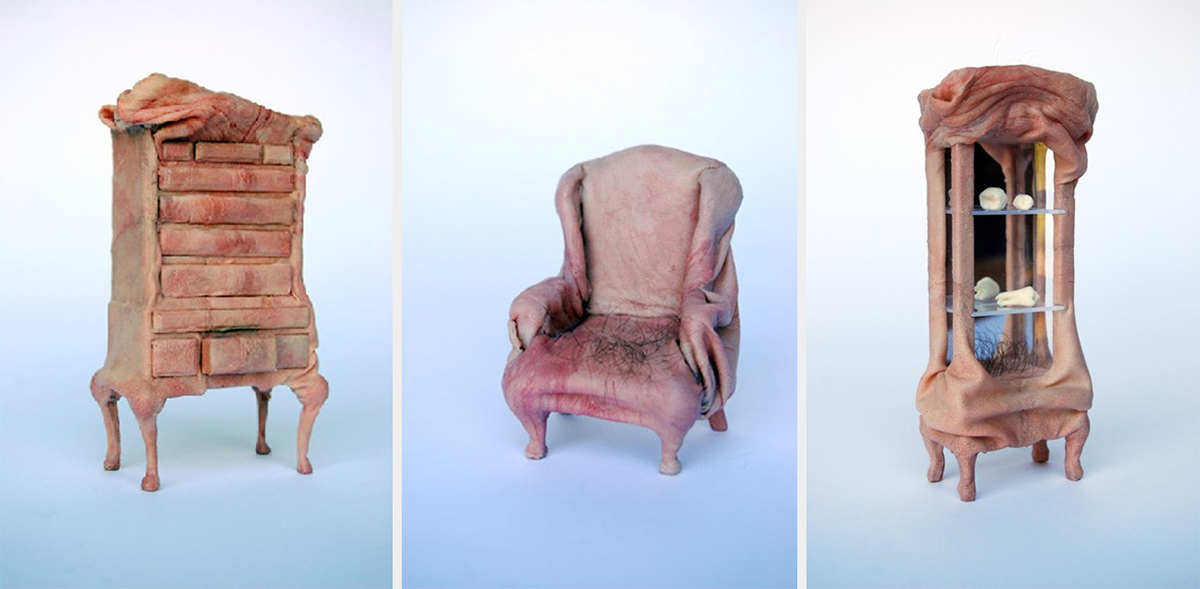
12 | Jessica Harrison, Untitled from the series Handheld, mixed media, 2008, private collection. Style identified by Giuliana Gardelli as Queen Anne.
13 | Jessica Harrison, Untitled from the series Handheld, mixed media, 2008, private collection. Style identified by Giuliana Gardelli as Queen Anne.
14 | Jessica Harrison, Untitled from the series Handheld, mixed media, 2009, private collection. Style identified by Giuliana Gardelli as Queen Anne.
Michael Stewart compares Harrison to the “champions of the subversive”, such as “Warhol, Johns, Bacon, Hockney, Hirst and Emin”, who have “taken a familiar, comfortable, safe and cosy institution [...] the art of the comic book, product design, branding, the national flag, the home, the traditional portrait and even domestic forniture” and “attacked from within” (Stewart 2014); a comparison that is all the more interesting in the light of Harrison’s creation of miniature furniture pieces. “The furniture pieces are cast from the palms of my hands so the fingerprints you see covering them are mine. It is not real skin, but it is real hair [...] They are particularly unsettling as they can fit so snugly in the hand or in other crevices of the body. This makes them seem more monstrous perhaps than if they were full-scale furniture pieces – the fact that they camouflage so well into your own body. You have to get really close to [the] miniatures so you can get a good look at them and by then it is too late, they are already right next to you before you realize you are looking at skin, hair and teeth” (Kelly 2011). Harrison has “experimented for a long time with different materials to get something that looked as close to skin as possible”, finally finding her “secret recipe” (ivi); the teeth are wax casts of her own teeth, as mentioned in Finel Honigman 2014 in discussing another artwork. She has also worked with found dollhouse items in which she has inserted, as she told me over email, a cast of her tongue. The ‘skin furniture’ series – powerful enough to fascinate a designer (Azzarello 2013) and a landscape photographer (Nunheim 2013) – is called Handheld, with reference to the pieces’ capability to fit in the crevices of the human body; Harrison has also staged some photos in which she actually holds the pieces in her hand. (I thought it useful to ask Ms. Gardelli to identify the styles of the furniture items as well).
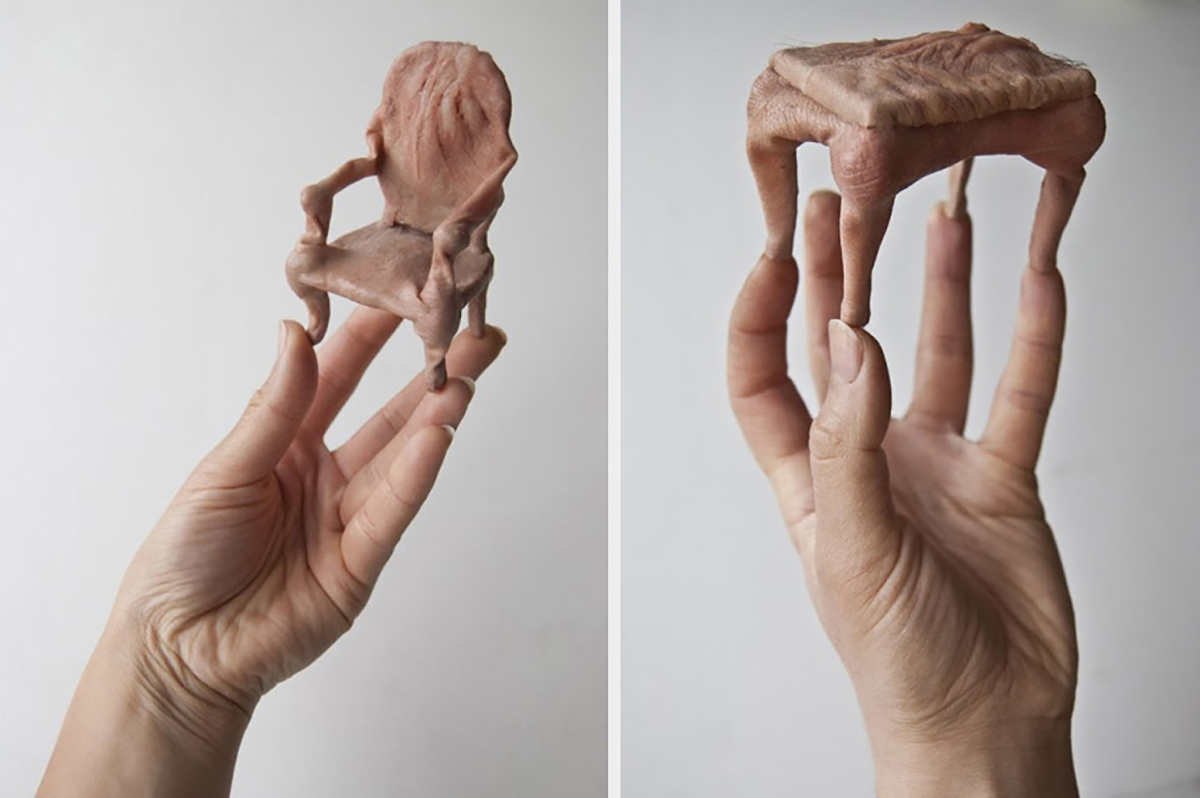
15 | Jessica Harrison, photograph staged in 2012 of Jessica Harrison, Untitled from the series Handheld, mixed media, 2008, private collection. Style identified by Giuliana Gardelli as 1750.
16 | Jessica Harrison, photograph staged in 2012 of Jessica Harrison, Untitled from the series Handheld, mixed media, 2008, private collection. Style identified by Giuliana Gardelli as 1750.
Also from Michael Stewart are these words that I have already quoted, “Harrison forces her audience to recognise their own conditioning [...] touching on attendant issues such as the manipulation of body shape through costume, gender roles, repression and conformity”. In his analysis of some Sade-esque works by Man Ray, Arturo Schwarz has pointed out how the three geometric solids in the assemblage Mire Universelle (also known as Target) are meant to threaten the Three Graces (Schwarz 1998, 21). But there is nothing violent-looking about the geometric solids in the three works that Harrison especially made for a 2015 exhibition: as per her statement, she was, indeed, “exploring the deformity of the body through costume” (Harrison 2015).
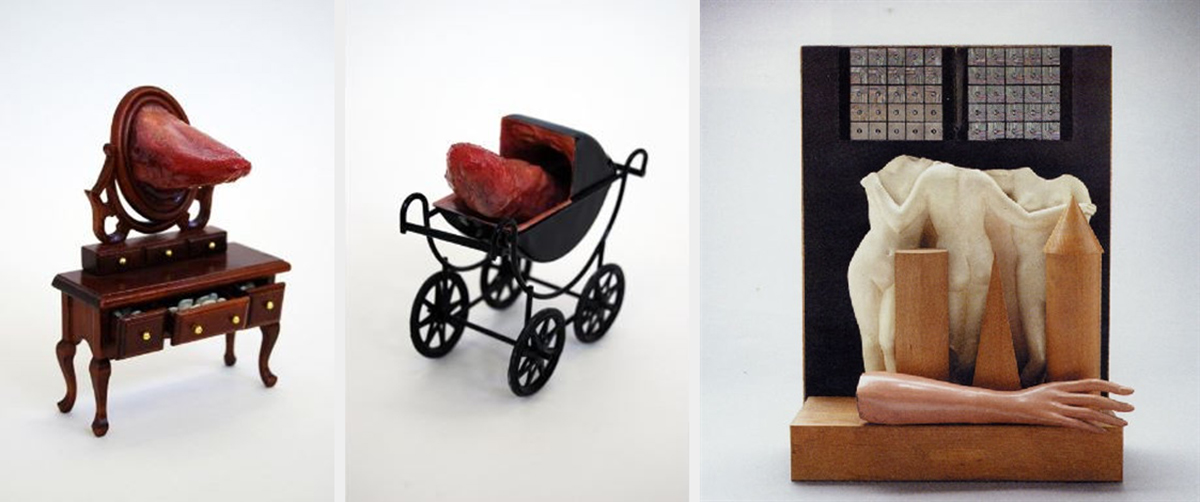
17 | Jessica Harrison, Untitled, found object, epoxy resin, enamel paint, and acrylic varnish, 2008, private collection. Style identified by Giuliana Gardelli as 1850.
18 | Jessica Harrison, Untitled, found object, epoxy resin, enamel paint, and acrylic varnish, 2008, private collection. Style identified by Giuliana Gardelli as early twentieth-century.
19 | Man Ray, Mire Universelle (also known as Target), found objects, 1933, destined for the Israel Museum in Jerusalem by donation of Arturo Schwarz, but stolen and not yet recovered.
With regard to gender roles, Stewart says that Harrison challenges them by incorporating “traditionally masculine characteristics” into her art, namely “the physical manifestations of violence such as wounding and scarring” – in the seriesBroken– as well as tattoos (Stewart 2014). When Fernando Vicente’s women happen to sport tattoos (or pubic hair), it comes across as glamorous, as part of the shooting they can be imagined as models posing for. But for her Painted Ladies, Harrison has chosen tattoo iconographies that are “from war-time source imagery, to recall a time before the popularity boom of the tattoo when it may be pointed more towards a particular kind of harsher life [...] masculine illustrations are intertwined with overtly over-idealized feminine costume” (del Castillo 2014). Among the tattoos covering the Painted Lady no.8 are the names of her many female conquests. While syphilis has inscribed, on the skin of Degas’s dancer, her condition of pariah, Harrison’s figurine unapologetically flaunts her status of tombeuse de femmes.

20 | Jessica Harrison, Untitled (Cube), found ceramic figurine, epoxy resin, and enamel paint, 2015, private collection. Style identified by Giuliana Gardelli as Victorian.
21 | Jessica Harrison, Untitled (Sphere), found ceramic figurine, epoxy resin, and enamel paint, 2015, private collection. Style identified by Giuliana Gardelli as eighteenth/nineteenth-century.
22 | Jessica Harrison, Untitled (Cone), found ceramic figurine, epoxy resin, and enamel paint, 2015, in possession of the artist at the time of submission of this paper. Style identified by Giuliana Gardelli as eighteenth/nineteenth-century.
23 | Detail from Jessica Harrison, Painted Lady no. 4, found ceramic figurine and enamel paint, 2014, private collection. Style identified by Giuliana Gardelli as turn-of-the-century.
24 | Detail from Jessica Harrison, Painted Lady no. 8, found ceramic figurine and enamel paint, 2014, private collection. Style identified by Giuliana Gardelli as turn-of-the-century.
This paper was aimed to take up one of the most exciting challenges for art scholars: being receptive to how artworks come across to non-specialist audiences (as well as to art professionals such as journalists and curators, thus bridging the gap between academic and non-academic art careers) and researching whether it is possible to validate their impressions and feelings. Most likely to be written about outside academia, Millennial artists like Jessica Harrison offer a precious opportunity to do so.
Bibliography and webography
- Azzarello 2013
N. Azzarello, Sculpted Skin Furniture by Jessica Harrison, https://www.designboom.com/art/sculpted-skin-furniture-by-jessica-harrison-12-16-2013/, 16 December 2013. - Carter [1966] 2014
A. Carter, Shadow Dance, London [1966] 2014. - Carter [1971] 2006
A. Carter, Love, London [1971] 2006. - Carter [1979] 2013
A. Carter, The Sadeian Woman. An Exercise in Cultural History, London [1979] 2013. - Castle 1995
T. Castle, The Female Thermometer. Eighteenth-Century Culture and the Invention of the Uncanny, New York 1995. - Dalí [1936] 1998
S. Dalí, The Spectral Surrealism of the Pre-Raphaelite Eternal Feminine [Le Surréalisme spectral de l’éternel féminin préraphaélite], “Minotaure” 8 (June 1936), 46-49. Retrieved from H. Finkelstein (ed. and transl.), The Collected Writings of Salvador Dalí, Cambridge 1998, 310-314. - del Castillo 2013
I. del Castillo, Bloody Victorian Ceramic Ladies by Jessica Harrison, http://www.lostateminor.com/2013/12/18/bloody-victorian-ceramic-ladies/, December 18, 2013. - del Castillo 2014
I. del Castillo, Stunning Tattoed Ceramic Ladies: We Interviewed the Artist behind Them, http://www.lostateminor.com/2014/06/07/interview-renowned-sculptor-behind-tattooed-ceramic-ladies-jessica-harrison/, 6 June 2014. - Foster [1995] 1996
S. L. Foster, The Ballerina’s Phallic Pointe, in Ead., Corporealities: Dancing Knowledge, Culture and Power, London [1995] 1996, 1-24. - Garner 2012
K. Garner, Blending the Pre-Raphaelite with the Surreal in Angela Carter’s Shadow Dance (1966) and Love (1971), in S. Andermahr, L. Phillips (eds.), Angela Carter: New Critical Readings, London 2012, 147-161. - Gori 2014
J. Gori, Fernando Vicente, Autopsy of Fashion, https://beautifulbizarre.net/2014/08/24/fernando-vicente-autopsy-fashion/, 24 August 2014. - Harrison 2015
Post on Jessica Harrison’s Facebook page: https://www.facebook.com/Jessicaharrisonstudio/photos/a.486551294693633.129586.150031935012239/1117374491611307/?type=3&theater, 5 June 2015. - Finel Honigman 2014
A. Finel Honigman, Interview with Jessica Harrison, https://blog.sculpture.org/2014/07/16/jessica-harrison/, 16 July 2014. - hubs 2016
hubs (blogger), Broken Porcelain Lady Figurines,http://www.artifacting.com/blog/broken-porcelain-lady-figurines/, 2 February 2016. - Kelly 2011
A. B. Kelly, Sugar and Spice and Everything Sliced: the Art of Jessica Harrison,https://www.huffingtonpost.com/anne-b-kelly/sugar-and-spice-and-every_b_818480.html, 16 March 2011 (updated 6 December 2017). - Mori 2004
G. Mori, Degas tra antico e moderno, Florence 2004. - Nodelman 2006
S. Nodelman, The Decollation of Saint Marcel, “Art in America” 94, no. 9 (October 2006), 107-119. - Nunheim 2013
A. Nunheim, Handheld, https://www.ignant.com/2013/04/05/handheld/, 5 April 2013. - Olda 2013
D. Olda, Ceramic Figurines with a Gory Twist by Jessica Harrison, http://hifructose.com/2013/12/18/ceramic-figurines-with-a-gory-twist-by-jessica-harrison/, December 18, 2013. - Paolucci 2017
M. Paolucci, British Poets and American Rockstars. A Journey through the Cave of Spleen, “Engramma. La tradizione classica nella memoria occidentale” 149, no. 9 (September 2017). - Ruddick-Sunstein 2014
E. Ruddick-Sunstein, These Delicate Victorian Figurines Have Some Badass Tattoos, http://beautifuldecay.com/tag/jessica-harrison/, May 20, 2014. - Schwarz 1998
A. Schwarz, Man Ray, Florence 1998. - Stewart 2014
M. Stewart, Broken: An Interview with Jessica Harrison, http://www.idesigni.co.uk/blog/idi-interviews-jessica-harrison/, July 30, 2014 (Link no longer working at the time of submission of this paper). - V1 2014
Video available on https://vimeo.com/102528366. - V2 2014
Video available on https://vimeo.com/102643368. - Weida 2011
C. L. Weida, Artistic Ambivalence in Clay: Portraits of Pottery, Ceramics, and Gender, Newcastle upon Tyne 2011. - West 2014
R. West, Jessica Harrison: Feminist Figurines, http://www.theskinny.co.uk/art/interviews/jessica-harrison-feminist-figurines, July 29, 2014. - zanimon 2012.
zanimon (blogging collective), Fernando Vicente – Illustration, https://llamasoftheworldunite.wordpress.com/2012/04/15/fernando-vicente-illustration/, April 15, 2012.
Acknowledgements
This paper has its roots in a talk I delivered in January 2017 at the History of Art Department of Sapienza University of Rome; so, first of all, I wish to thank Professor Antonella Sbrilli for entrusting me with delivering it.
Then I would like to thank artists Jessica Harrison and Fernando Vicente for providing me with all the information I needed; and, of course, to express my deepest gratitude to Ms. Giuliana Gardelli, whose expertise made writing this paper possible.
English abstract
With the help of a ceramics specialist, this paper lends scholary credence to the statements about ‘Millennial’ artist Jessica Harrison’s work made by non-academic critics across blogs and magazines. Working off the premise that Harrison’s work with found ceramic figurines is not only traceable back to the Surrealist modus operandi, but also discussable with reference to the Surrealist mindset, the paper puts a spotlight on the eighteenth- and nineteenth-century styles of the figurines in order to explore the influence that both centuries exercised over Surrealism; another strong point lies in broadening the discourse to the similar blending of aesthetics in the work of another British woman, author Angela Carter. Harrison’s uniqueness in the ‘gore art’ scene – as well as her difference from the Surrealists – is highlighted by discussing how artists can exploit the expressive power of gestures; focus is also placed on the dialogue between the object and the setting it is exhibited in.
keywords | ceramic, Jessica Harrison, Surrealism, figurines, Angela Carter, gore art.
Per citare questo articolo/ To cite this article: M.Paolucci, The British Uncanny. Reusing Surrealist Energies in Jessica Harrison’s Art, ”La rivista di Engramma” n.158, settembre 2018, pp. 57-78 | PDF